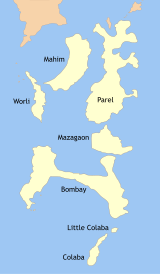
The seven islands of Bombay were an archipelago of islands that were, over a span of five centuries, connected to form the area of the modern city of Mumbai. The seven islands were gradually physically united through land reclamation projects. The original archipelago was composed of the following islands:
- Isle of Bombay,
- Colaba
- Old Woman’s Island (Little Colaba)
- Mahim
- Mazagaon
- Parel
- Worli
The nearby islands of Trombay and Salsette were merged to form Greater Bombay.
The remaining islands are:
- Gharapuri Island/Elephanta Island
- Butcher Island
- Middle Ground Coastal Battery
- Oyster Rock
- East Ground
In the 1970s, the Supreme Court instituted a series of injunctions protecting the shoreline and access to it for fishermen. These injunctions, along with the creation of Coastal Regulatory Zones in the 1990s and growing environmental concerns, have significantly decreased the number and scale of land reclamation projects pursued in Mumbai.
Details
- It took over 150 years to join the original seven islands of Mumbai. These seven islands were lush green thickly wooded, and dotted with 22 hills, with the Arabian Sea washing through them at high tide.
- The original island of Mumbai was only 24 km long and 4 km wide from Dongri to Malabar Hill (at its broadest point) and the other six were Colaba, Old Woman’s island, Mahim, Parel, Worli, Mazgaon.
- The first major reclamation took place in 1708, to construct the causeway (a causeway is a road or railway elevated, usually across a broad body of water or wetland.) between Mahim and Sion.
- The second major reclamation took place in 1772, to stop the ingress of water and the consequent flooding of central Mumbai, and to connect Mahalaxmi and Worli. This is regarded as the oldest unauthorised construction that took place in Mumbai and the offender was the erstwhile Governor of Mumbai, William Hornby at a total expenditure Rs 1,00,000.
- The approval for the reclamation had been sought from the company of directors in England, Hornby did not expect a rejection and went ahead with the construction. The rejection arrived a year later, but, the causeway was complete and Hornby was sacked. This causeway was named Hornby Vellard, sealing the Great Breach (Breach Candy) between Dongri, Malabar hill and Worli.
- In 1803, Mumbai was connected to Salsette by a causeway from Sion. Colaba Causeway joined the island of Colaba to Mumbai in 1838, and Mahim and Bandra were connected by a causeway in 1845 at a total cost of Rs 1, 57, 000 donated entirely by Lady Avabai Jamsetjee Jeejeebhoy, wife of the first baronet Sir Jamsetjee Jeejeebhoy (the government refused to build these causeways).
- After that a series of causeways were built under different governors.
- Independence did not end the reclamation work but a third Backbay Reclamation was put into effect and yielded the acreage on which stand the high rises of Nariman Point and Cuffe Parade.
- Eventually, the Supreme Court injunction protecting the shoreline and access for fishermen has slowed down the work since 1970. The Supreme Court has added more restriction in 1990s with the Coastal Regulatory Zones.
- The Backbay Reclamation Project symbolised a major shift in the spirit of the city from Victorian to an International city.